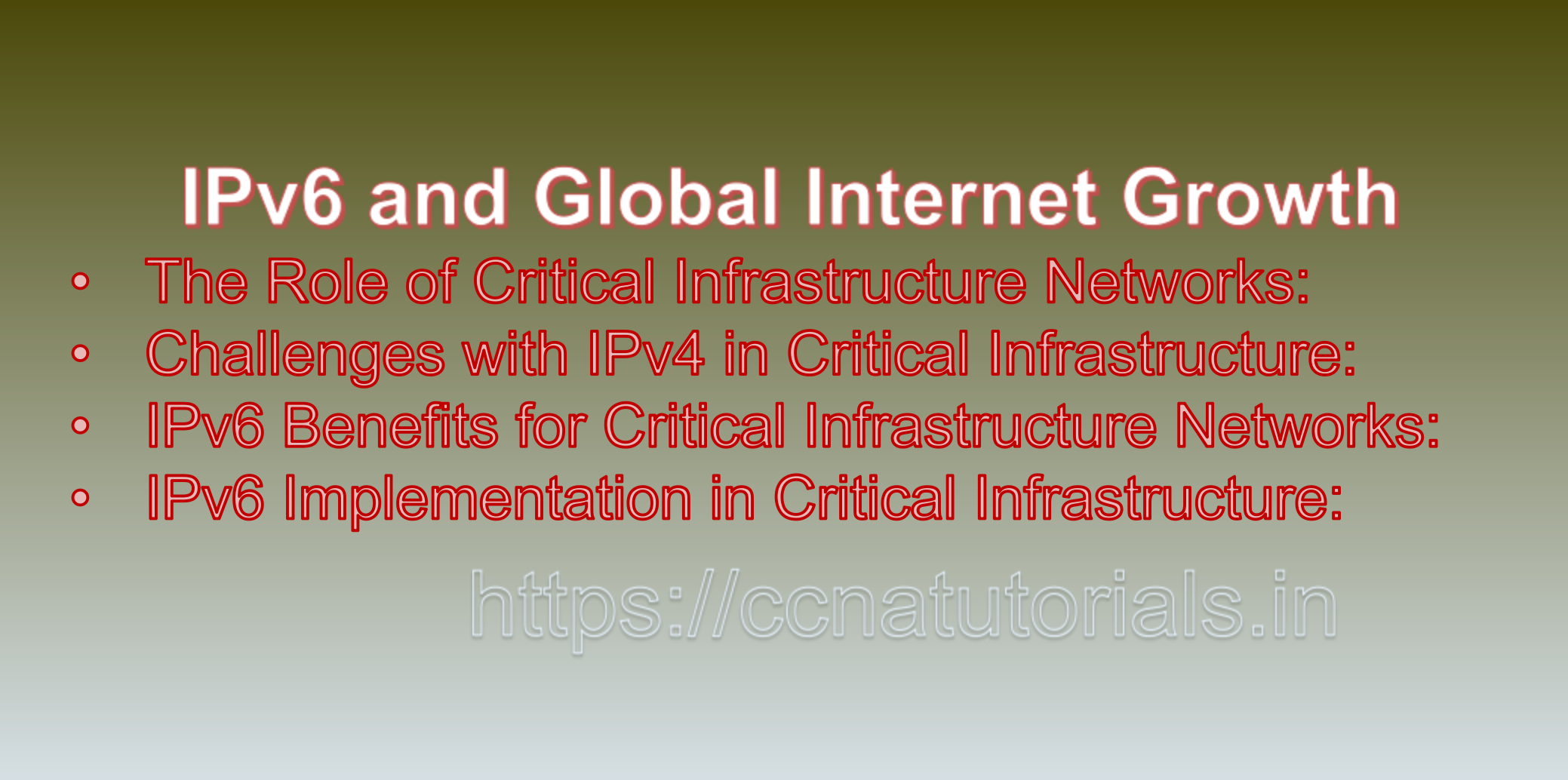Contents of this article
In this article, I describe IPv6 in Critical Infrastructure Networks: Strengthening Resilience and Reliability. Critical infrastructure networks are the backbone of modern society, encompassing sectors such as energy, transportation, healthcare, and more. The transition to Internet Protocol version 6 (IPv6) is of paramount importance in these networks to ensure their resilience, security, and scalability. IPv6 addresses the limitations of Internet Protocol version 4 (IPv4) and provides enhanced features that are crucial for maintaining the integrity and functionality of critical infrastructure systems. This article delves into the significance of IPv6 in critical infrastructure networks and provides examples of how its adoption strengthens their operation.
1. The Role of Critical Infrastructure Networks:
Critical infrastructure networks underpin essential services that society relies on daily. These networks include power grids, transportation systems, emergency services, water treatment plants, and more. The reliability and security of these networks are vital to public safety, economic stability, and overall well-being.
2. Challenges with IPv4 in Critical Infrastructure:
– Address Exhaustion:
IPv4’s limited address space poses challenges when trying to accommodate the growing number of devices in critical infrastructure networks.
– Security Concerns:
IPv4’s lack of built-in security features makes critical infrastructure systems susceptible to cyber threats and attacks.
– Network Scalability:
The inability to scale effectively can hinder the expansion of critical infrastructure services to meet growing demands.
3. IPv6 Benefits for Critical Infrastructure Networks:
– Abundant Address Space:
IPv6 provides an immense address pool, ensuring that critical infrastructure networks can allocate addresses to all devices without concerns about address depletion.
– Enhanced Security:
IPv6 incorporates mandatory support for Internet Protocol Security (IPsec), which ensures data confidentiality, integrity, and authentication, mitigating security risks.
– Efficient Routing:
IPv6’s simplified header structure and improved routing mechanisms result in more efficient and faster routing of data packets, critical for time-sensitive operations.
– Mobility Support:
IPv6’s inherent support for mobile devices enables seamless communication for field operations and remote monitoring in critical infrastructure sectors.
4. IPv6 Implementation in Critical Infrastructure:
– Energy Sector:
– Case Study: Smart Grid Implementation: An energy company upgrades its power distribution network to a smart grid. By adopting IPv6, the company ensures that the smart meters, sensors, and grid management systems can communicate efficiently, enabling real-time monitoring and precise energy distribution.
– Transportation Sector:
– Case Study: Intelligent Transportation Systems (ITS): A city implements ITS to manage traffic flow and optimize transportation services. IPv6 integration allows traffic lights, cameras, and vehicle-to-infrastructure communication systems to operate seamlessly, enhancing traffic management and reducing congestion.
– Healthcare Sector:
– Case Study: Telemedicine Network: A healthcare facility establishes a telemedicine network to provide remote medical consultations. IPv6 enables secure communication between medical devices, patient records, and healthcare professionals, ensuring privacy and quality care.
– Water Treatment Sector:
– Case Study: Smart Water Management: A water treatment plant modernizes its operations using IoT sensors and data analytics. IPv6 integration ensures that sensors, pumps, and control systems can exchange data efficiently, optimizing water treatment processes and reducing wastage.
5. Implementation Steps for IPv6 in Critical Infrastructure:
– Risk Assessment:
Identify the specific needs and vulnerabilities of critical infrastructure networks, considering security requirements and potential challenges.
– Infrastructure Evaluation:
Assess the compatibility of existing equipment and systems with IPv6. Upgrade or replace components as needed.
– Address Planning:
Develop a comprehensive addressing plan that aligns with the hierarchical structure of IPv6, accommodating the scale of critical infrastructure networks.
– Security Measures:
Implement IPsec for end-to-end encryption, integrity, and authentication. Establish firewalls, intrusion detection systems, and regular security audits.
– Testing and Training:
Thoroughly test the IPv6 implementation for compatibility and performance. Provide training to personnel to ensure they understand IPv6’s operation and security features.
6. Benefits of IPv6 in Critical Infrastructure Networks:
– Resilience:
IPv6’s enhanced security and efficient routing mechanisms contribute to the resilience of critical infrastructure networks, protecting them from cyber threats and ensuring uninterrupted operations.
– Scalability:
The abundant address space and optimized routing in IPv6 support the scalability of critical infrastructure systems, accommodating future growth and evolving demands.
– Interoperability:
IPv6’s universal adoption facilitates interoperability between devices and systems, allowing different components of critical infrastructure networks to communicate seamlessly.

In short IPv6 in Critical Infrastructure Networks : Building Strong and Secure Critical Infrastructure Networks:
The integration of IPv6 into critical infrastructure networks is crucial for ensuring their reliability, security, and adaptability. By overcoming the limitations of IPv4, IPv6 empowers critical infrastructure sectors to harness the benefits of abundant addressing, enhanced security, efficient routing, and mobility support. As critical infrastructure networks continue to evolve and expand, IPv6 provides a robust foundation that strengthens their ability to provide essential services and withstand challenges. Embracing IPv6 is not only a technological advancement but also a strategic imperative to safeguard the well-being of society and maintain the functionality of critical services.
IPv6 in Critical Infrastructure Networks: Strengthening Resilience and Connectivity
Critical infrastructure networks, such as those supporting energy, transportation, healthcare, and public safety, play a vital role in society’s functioning. The transition from Internet Protocol version 4 (IPv4) to Internet Protocol version 6 (IPv6) is of significant importance for these networks. IPv6 offers enhanced security, efficient communication, and scalability, addressing the limitations of IPv4 and providing a robust foundation for the critical operations of these industries. This article explores the role of IPv6 in critical infrastructure networks, highlighting its benefits and providing examples of how IPv6 enhances resilience and connectivity.
1. Challenges in Critical Infrastructure Networks:
– Growing Demand:
Critical infrastructure networks are experiencing a surge in demand due to increased reliance on digital technologies and services. IPv6’s expanded address space supports the growing number of devices and services within these networks.
– Security Concerns:
Security is paramount for critical infrastructure networks, as any disruptions can have serious consequences. IPv6 incorporates improved security features, including mandatory support for Internet Protocol Security (IPsec), enhancing the protection of data and communication.
2. Benefits of IPv6 in Critical Infrastructure Networks:
– Address Space:
IPv6’s vast address space ensures that critical infrastructure networks can allocate unique addresses to a multitude of devices, preventing address exhaustion and enabling future growth.
– Security Enhancements:
IPv6’s mandatory IPsec support provides end-to-end encryption and authentication, ensuring data integrity and confidentiality across the network.
– Efficient Routing:
IPv6’s simplified and efficient routing header improves the routing process, reducing the burden on network devices and enhancing overall performance.
– Mobility Support:
For industries like transportation and public safety, IPv6’s mobility features enable seamless communication as devices move within and across networks.
3. IPv6 Implementation in Critical Infrastructure Networks:
– Energy Sector:
Utilities and power grids can benefit from IPv6’s secure communication and efficient data exchange. IPv6 enables the connectivity of smart meters, sensors, and control systems, enhancing the monitoring and management of energy distribution.
– Transportation Industry:
IPv6 is crucial for intelligent transportation systems, enabling real-time communication between vehicles, traffic lights, and central management systems. This facilitates traffic optimization, reducing congestion and enhancing road safety.
– Healthcare Sector:
In healthcare, IPv6 supports the connectivity of medical devices, electronic health records, and telemedicine platforms. The enhanced security of IPv6 safeguards sensitive patient data during transmission.
– Public Safety and Emergency Services:
IPv6 ensures seamless communication for emergency services, allowing first responders to coordinate effectively during crises. Mobile IPv6 enables devices used by emergency personnel to stay connected while moving within different coverage areas.
– Water and Wastewater Management:
IPv6 can enhance the monitoring and management of water distribution and wastewater treatment systems. IoT devices can be deployed to collect data from sensors and transmit it securely over IPv6 networks.
4. IPv6 in Critical Infrastructure Case Studies:
– Smart Grid Implementation:
– Utility Company Scenario: A utility company adopts IPv6 to modernize its smart grid infrastructure. IPv6 enables real-time communication between smart meters, substations, and central control centers, enhancing grid efficiency and resilience.
– Intelligent Transportation System:
– City Transportation Department: A city’s transportation department implements IPv6 to enable communication between traffic lights, surveillance cameras, and vehicles. This IPv6-powered intelligent transportation system improves traffic flow, reduces congestion, and enhances overall road safety.
– Healthcare Network Enhancement:
– Hospital Network: A hospital network deploys IPv6 to support the connection of medical devices, patient records, and telemedicine services. IPv6’s security features ensure the confidentiality of patient data during transmission, contributing to improved patient care.
5. Implementation Steps for IPv6 in Critical Infrastructure:
– Assessment:
Evaluate the existing network infrastructure, devices, and services to determine the feasibility of IPv6 integration.
– Planning:
Develop a comprehensive IPv6 deployment plan that addresses specific requirements, challenges, and migration strategies tailored to the critical infrastructure industry.
– Testing and Validation:
Conduct thorough testing in a controlled environment to ensure that IPv6-enabled devices and services perform as expected.
– Security Measures:
Implement IPv6-specific security measures, such as IPsec, to safeguard critical data and communication.
6. Benefits of IPv6 in Critical Infrastructure Networks:
– Resilience:
IPv6’s security features and efficient routing contribute to the resilience of critical infrastructure networks, minimizing disruptions and downtime.
– Scalability:
IPv6’s expansive address space supports the growth of connected devices and services, ensuring scalability to meet increasing demands.
– Secure Communication:
IPv6’s mandatory IPsec support enhances data security and confidentiality, protecting critical information from unauthorized access and interception.
Conclusion for IPv6 in Critical Infrastructure Networks, Fortifying Critical Infrastructure with IPv6:
IPv6’s introduction into critical infrastructure networks marks a significant step toward enhancing resilience, security, and efficiency. As industries such as energy, transportation, healthcare, and public safety embrace the capabilities of IPv6, they are better equipped to meet the challenges of a rapidly evolving digital landscape. By adopting IPv6, critical infrastructure networks can ensure seamless communication, robust security, and a foundation for sustainable growth, ultimately contributing to the overall safety and well-being of society.






